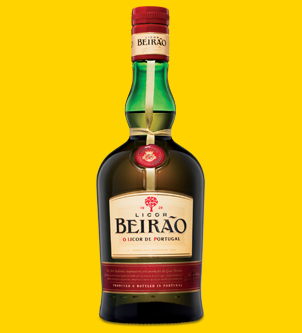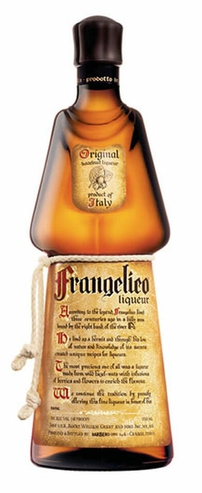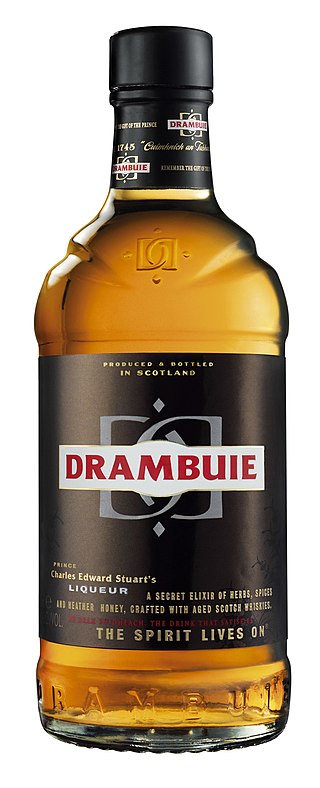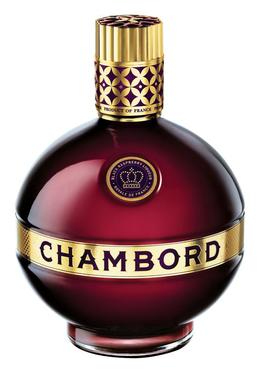
A liqueur is an alcoholic drink composed of spirits and additional flavorings such as sugar, fruits, herbs, and spices. Often served with or after dessert, they are typically heavily sweetened and un-aged beyond a resting period during production, when necessary, for their flavors to mingle.

Vodka is a clear distilled alcoholic beverage. Different varieties originated in Poland, Russia, and Sweden. Vodka is composed mainly of water and ethanol but sometimes with traces of impurities and flavourings. Traditionally, it is made by distilling liquid from fermented cereal grains, and potatoes since introduced in Europe in the 1700's. Some modern brands use corn, sugar cane, fruits, honey, and maple sap as the base.

Smirnoff is a brand of vodka owned and produced by the British company Diageo. The Smirnoff brand began with a vodka distillery founded in Moscow by Pyotr Arsenievich Smirnov (1831–1898). It is distributed in 130 countries. Smirnoff products include vodka, flavoured vodka, and malt beverages. In 2014, Smirnoff was the best selling vodka around the world.

Chartreuse is a French herbal liqueur available in green and yellow versions that differ in taste and alcohol content. The liqueur has been made by Carthusian monks since 1737 according to instructions set out in a manuscript given to them by François Annibal d'Estrées in 1605. It was named after the monks' Grande Chartreuse monastery, located in the Chartreuse Mountains north of Grenoble. Today the liqueur is produced in their distillery in nearby Aiguenoire. It is composed of distilled alcohol aged with 130 herbs, plants and flowers.

Sloe gin is a British red liqueur made with gin and sloes. Sloes are the fruit (drupe) of Prunus spinosa, the blackthorn plant, a relative of the plum. Sloe gin has an alcohol content between 15 and 30 percent by volume. However, the European Union has established a minimum of 25% ABV for sloe gin to be named as such. Sloe gin is technically a gin-based liqueur, but due to historical prevalence at the time of writing the EU spirit drink regulations, the colloquial name 'sloe gin' was included in the legal definitions and as such is the only gin-based liqueur that can legally be called gin without the liqueur suffix. The traditional way of making sloe gin is to soak the sloes in gin. Most recipes call for the addition of sugar, but this is not required. The drink develops sweetness when the fruit is left in the alcohol and is allowed to mature. The addition of sugar is actually likely to inhibit the passage of flavour compounds from the fruit into the spirit, due to a reduction in osmotic pressure; a common criticism of sloe gin is that it is much too sweet.

Frangelico is a brand of noisette and herb-flavored liqueur coloured with caramel coloring, which is produced in Canale, Italy. It is 20% alcohol by volume (ABV) or 40 proof. Formerly, it was 24% ABV or 48 proof. When produced by the Barbaro family it was bottled at 28% ABV or 56 proof. The brand was created in 1978. It is known for its unusual packaging; its bottle was designed to look like a Christian friar, complete with a knotted white cord around the waist. It is most commonly sold in two sizes: 750ml and 375ml.

Pimm's is an English brand of gin-based fruit cup but may also be considered a liqueur or the basis of a sling or punch. It was first produced in 1823 by James Pimm and has been owned by Diageo since 1997. Its most popular product is Pimm's No. 1 Cup, commonly used for the Pimm's cup cocktail.

Liquor is an alcoholic drink produced by the distillation of grains, fruits, vegetables, or sugar that have already gone through alcoholic fermentation. Other terms for liquor include: spirit, distilled beverage, spirituous liquor or hard liquor. The distillation process concentrates the liquid to increase its alcohol by volume. As liquors contain significantly more alcohol (ethanol) than other alcoholic drinks, they are considered 'harder'; in North America, the term hard liquor is sometimes used to distinguish distilled alcoholic drinks from non-distilled ones, whereas the term spirits is more common in the UK. Some examples of liquors include vodka, rum, gin, and tequila. Liquors are often aged in barrels, such as for the production of brandy and whiskey, or are infused with flavorings to form flavored liquors, such as absinthe.

Drambuie is a golden-coloured, 40% ABV liqueur made from Scotch whisky, heather honey, herbs and spices. The brand was owned by the MacKinnon family for 100 years, and was bought by William Grant & Sons in 2014.

Chambord is a 16.5% abv raspberry liqueur modelled after a liqueur produced in the Loire Valley of France during the late 17th century. The Chambord product brand has been owned and produced by the Brown-Forman Corporation since 2006.
Rectified spirit, also known as neutral spirits, rectified alcohol or ethyl alcohol of agricultural origin, is highly concentrated ethanol that has been purified by means of repeated distillation in a process called rectification. In some countries, denatured alcohol or denatured rectified spirit may commonly be available as "rectified spirit", because in some countries the retail of rectified alcohol in its non-denatured form is prohibited.

Krupnik or Krupnikas (Lithuanian) is a traditional sweet alcoholic drink similar to a liqueur, based on grain spirit and honey, popular in Poland and Lithuania. In Poland it is grouped in the nalewka category of alcoholic beverages. Mass-produced versions of krupnik consist of 40–50% alcohol, but traditional versions will use 80–100% grain alcohol as the base. Honey, usually clover honey, is the main ingredient used to add sweetness, as well as up to 50 different herbs. There are many versions and some recipes have been passed down through generations; producers typically use their own recipes.

Steinhäger is a type of German gin, a spirit flavoured with juniper berries. The name is derived from the Westphalian municipality of Steinhagen, the only place where it is permitted to be produced.

Beefeater Gin is a brand of gin owned by Pernod Ricard and bottled and distributed in the United Kingdom. Beefeater remained in the control of its founding Burrough family until 1987. It is a 47% or 44% alcohol product in the US, and a 40% alcohol product elsewhere in the world. The Beefeater distillery is one of 24 in London.

Amaro is an Italian herbal liqueur that is commonly consumed as an after-dinner digestif. It usually has a bitter-sweet flavour, sometimes syrupy, and has an alcohol content between 16% and 40%.

Korn, also known as Kornbrand or Kornbranntwein, is a German colorless distilled beverage produced from fermented cereal grain seed. The production of Korn uses only five grains: most of the production is based on rye or wheat; barley is mainly used to obtain the required malt for the brewing process; oats and buckwheat are rarely used. The addition of food colorings, flavorings, or sweeteners is not permitted. Korn is distilled to lower alcoholic proofs and less rigorously filtered than vodka, which leaves more of the cereal grain flavor in the finished spirit.
Irish Mist is an Irish whiskey-based liqueur produced in Tullamore, Ireland, by the Irish Mist Liqueur Company Ltd. In September 2010 it was announced that the brand was being bought by Gruppo Campari from William Grant, only a few months after Grants had bought it from the C&C Group. It is made from aged Irish whiskey, heather and clover honey, aromatic herbs, and other spirits, blended to an ancient recipe claimed to be 1,000 years old. Though it was once 80 US proof, Irish Mist is now 35% or 70 US proof. The bottle shape has also been changed from a "decanter" style to a more traditional whiskey bottle shape. It is currently available in more than 40 countries.
Heidegeist is a herbal liqueur that is sold especially in the area of the Lüneburg Heath in northern Germany. The name means "heath spirit" or "heath ghost".

Soplica is one of the older brands of Polish pure and flavoured vodka, having been first produced in 1891. Although the origins of vodka in Poland can be traced back to as early as the 8th century, Soplica is one of the older industrially produced brands of vodka in the country. Żubrówka, for example, is based on a much older recipe than Soplica but exists as an industrially produced brand only since the 1920s.

















